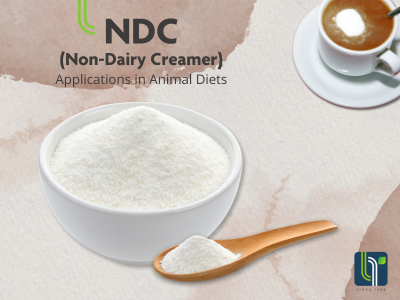Non-dairy creamer (NDC) is a popular additive known for its diverse applications in food, including as a milk substitute. However, its potential in animal diets is often overlooked. In this blog post, we will delve into the various ways NDC can be incorporated into animal diets to enhance nutrition and cost-effectiveness.
NDC is a blend of food additives commonly used as a coffee creamer or whitener. It is formulated to mimic the taste and texture of dairy creamer and is commonly used in beverages, oatmeal, hot chocolate, and baked goods. NDC typically contains:
The ingredients are normally formulated as an emulsion which is subsequently dried, preferably spray-dried, and sold in the form of a powder.
Product Properties:
This makes it a versatile ingredient in animal diets, especially in milk replacers for piglets and calves. The oil source, fat level, sodium caseinate test, color, and flavor might all be different. For example, it may be classified into three varieties based on its fat content: low fat, medium fat, and high fat. The major fatty acids in non-dairy creamer are lauric acid, myristic acid, stearic acid, and palmitic acid, which are saturated fatty acids. They do not contain lactose and therefore are commonly described as not being dairy products, although many contain casein, a milk-derived protein.
Applications of Non-Dairy Creamer in Animal Diets:
It is advisable to include the non-dairy creamer in animal diets at a moderate level, initially replacing a small portion of the total energy source and then gradually increasing the replacement level based on animal response. Monitoring animal performance, health, and digestive function is crucial when introducing a new ingredient like NDC into the diet.
Note: It’s important to consult with a nutritionist or veterinarian experienced in animal diets to determine the optimal level of NDC replacement and ensure a balanced diet for animals.
Precautions and Considerations:
When including NDC in feed concentrates for adult cows with a mature rumen system, precautions should be taken due to the potential for corn syrup to cause acidosis. It is advisable to supplement with sodium bicarbonate when feeding cows concentrates containing high-digestible carbohydrates. Long-term feeding practices should be avoided in these cases.
However, there is less concern when feeding NDC to calves, as they have an esophageal groove that bypasses the rumen.
Conclusion:
NDC presents a valuable alternative ingredient in animal diets, offering taste, energy, and cost benefits. By understanding its properties and applications, farmers and nutritionists can optimize its use to improve animal nutrition and performance while concurrently reducing costs. For inquiries regarding NDC supply, kindly contact Lam Tak by leaving your contact information here.

For more information